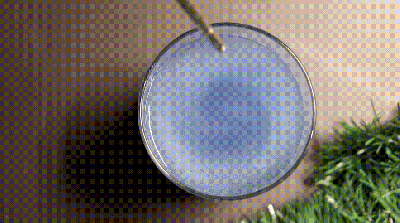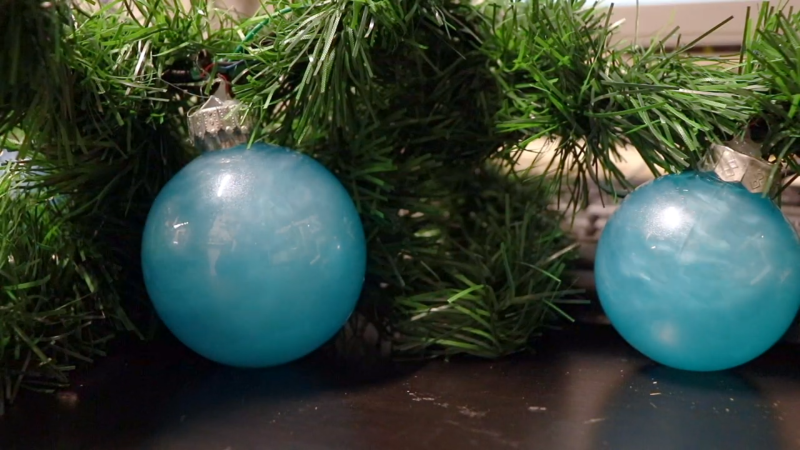We had to look it up on Wikipedia – “Rheoscopic fluid means ‘current showing’ fluid. Such fluids are effective in visualizing dynamic currents in fluids, such as convection and laminar flow. They have microscopic crystalline platelets such as mica, metallic flakes, or fish scales, in suspension in a fluid such as water or glycol stearate.” And so it seems [Will Donaldson] has figured out a great way to Animate Christmas Ornaments using Rheoscopic Fluid, just in time for the holiday season.
Making the fluid is pretty simple, and uses just a few readily available materials – distilled water, rheoscopic fluid concentrate and your choice of food colouring. The hardware is dead simple too – clear, spherical baubles with lids and core-less DC motors such as used in mini and nano drones, to agitate the fluid. You can use cell phone vibration motors too, but [Will]’s experimentation suggests that the level of agitation is not a lot.
 To make a bauble, you fill it with the fluid, hot glue the motor to the lid, close the lid such that the motor and its agitator are dunked in the fluid, and dab a generous amount of hot melt glue to seal it all shut. Then, hook it up to a suitable power supply and get enchanted by the mesmerising movements of the rheoscopic fluid in the bauble. The agitator is just a plain ol’ drone propeller forced in to a shape that is narrow enough to be pushed through the neck of the bauble. It’s a seasonal ornament, so don’t expect the motors to last long being submerged in the rheoscopic fluid. [Will]’s contraptions have not yet failed after a couple of days, and it may be safe to estimate that the motors may last about a week or two at most. Of course, YMMV depending on if you used distilled water or plain tap water and other factors.
To make a bauble, you fill it with the fluid, hot glue the motor to the lid, close the lid such that the motor and its agitator are dunked in the fluid, and dab a generous amount of hot melt glue to seal it all shut. Then, hook it up to a suitable power supply and get enchanted by the mesmerising movements of the rheoscopic fluid in the bauble. The agitator is just a plain ol’ drone propeller forced in to a shape that is narrow enough to be pushed through the neck of the bauble. It’s a seasonal ornament, so don’t expect the motors to last long being submerged in the rheoscopic fluid. [Will]’s contraptions have not yet failed after a couple of days, and it may be safe to estimate that the motors may last about a week or two at most. Of course, YMMV depending on if you used distilled water or plain tap water and other factors.
As [Will] suggests, if you prefer slower swirls, or random agitation, then it’s best to hook up a micro-controller and motor driver for fancy effects. At this point, it may be tempting to think of embedding LED’s inside the baubles, but doing so reduces the rheoscopic effect since it relies on reflecting light shining on it from the outside. The video embedded after the break has all the build details.
It’s a great way to teach some science to the kids during the holidays and maybe even get them to help with the project. And don’t assume this is just a cheap Christmas trick. Artist Paul Matisse has invented an art device/technique based on rheoscopic fluids which he calls “Kalliroscope©”. He patented it in 1968, and has sold Kalliroscope artworks throughout the world since then. From his website “A Kalliroscope is a device for viewing fluid currents. Kalliroscopes are both works of art and intuitively educational displays of the scientific principles of fluid dynamics. They are glass and steel constructions containing a current-visualizing fluid.” We’re not sure how priceless those works of art are, but it’s safe to assume you need deep pockets to buy one. So go ahead, turn your Christmas Tree in to a work of Art !
















This looks interesting for a sensory bottle also.
I also wonder how a fluorescing dye, or a LED would look….. Ideas.
Really cool btw.
Very cool effect. I second the idea about trying other dyes (UV for example)
I think I good idea would be to make a magnetic stirrer.
Use UV dyes and UV light from the inside! Or just white light with the normal food colouring. Might need a few light sources, as I’m not sure how well any of those suspensions will do when backlit – but the effect should be impressive.
I’d also go for magnetic stirring – sink a glass? tube (test-tube perhaps) with the led and some coils into the centre of the ornament – keeps all the electrics and fluids separate. Which if you do it right means you should be able to fix the electronics should anything break easily.
Thinking about it if you use the tube in ball method you can have a plastic? agitator at the very bottom of the balls driven by the magnets forces (or even press fit the motor into the tube) – if it fits to the ball pretty well it should rapidly pull any stuck particles off the bottom as the flow over them will be intense. Might need to be too close to the side wall such that you end up with a ‘south pole’ of the agitator, where the effect doesn’t really happen though.
Mineral oil instead of water shouldn’t burn out the motor.
I wonder if simple magnetic stirring could be employed here for a longer lasting ornament…
My idea too! Put a ball like that on a wooden base would make for a nice DIY perks video!
For a permanent display like a table-top cylinder you could do magnetic stiring with a motor turning a bar magnet underneath a flask and another bar magnet inside the flask. The motor/magnet assembly could be housed inside a completely sealed plastic base unit allowing the flask to be lifted off.
Maybe a small teflon magnetic stirrer like for a leb in the ornament — spin it from the outside w no electric contact at all?
Never mind – his original solution is more self contained and works just fine. Very nice.
One step away from microplastic. Looks nice, but imho it‘s not the way to go. What about a small heater and a lava lamp style bouble? Endless possibilities, think 70s disco lights effects. Take a laser diode and a spinning mirror and sink them in tainted oil. Please don‘t use glitter or eben smaller particle mica powder.
Rheoscopic “fluid” isn´t / shouldn´t be microplastic, but crystalline silica.
I was thinking about lava lamping it too, also you could run it with a candle, just for fun.
The tiny steppers from cameral lenses would be a good choice, no brushes to corrode, should last indefinitely. And they are very cheap on eBay.
Aircraft tend to have electric motors in the fuel tanks, using the fuel to cool a motor smaller than would normally be acceptable. (I built a test rig / dyno for them, including the fuel flow-through)
Automotive fuel pumps are similar and a lot easier to find. Too big to fit into an ornament, unless someone wants to build a really big one.
I wasn’t suggesting using fuel pumps, just pointing out that using motors immersed in fluid is actually very common.
If you want to know a bit more about rheoscopic fluids there is an instructable that tells you how to make it. https://www.instructables.com/Making-Rheoscopic-Fluid/
Or you just buy it in a variety of colors. PC modders have been using it since at least 2012 if nor earlier.
https://youtu.be/s1GwP9FiQjQ
https://youtu.be/ovP9zN5EJhA
Or you can just buy it. PC modders have been using this stuff since at least 2012. Mayhems, Primochill and I think even EK all sell it still.
https://youtu.be/ovP9zN5EJhA?t=11
Having such Christmas balls moving each different way could be a little bit disturbing. But I can imagine using this for a bigger sphere like those table “magic” crystal balls or some “simulation” lamp imitating for example the movement of Jupiter’s atmosphere – e.g. using the fluid plus some orange dye and maybe some LED lights … With some continuously changing random motion it could be a really nice and maybe calming lamp.